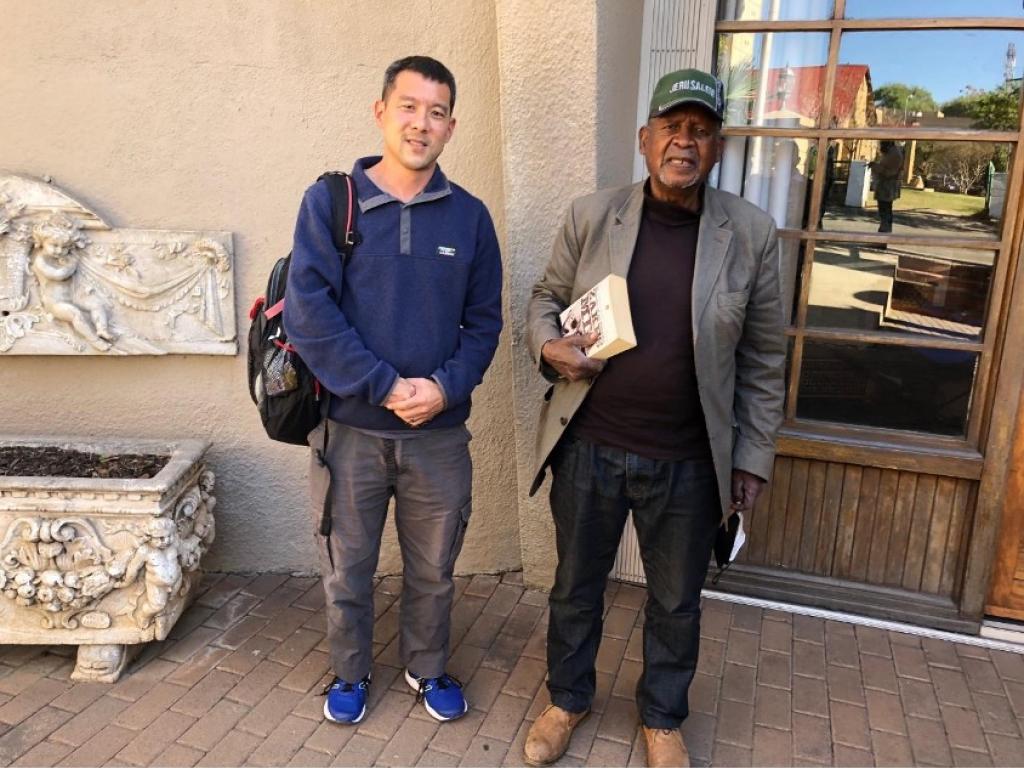Multiple Avenues to Lesotho’s Past

Generally, when you go off on a research trip to look at archives and interview interlocutors, you do not expect scenery. When first arriving at Morija in Lesotho you are struck first by the landscape, with a sweeping valley running up to the Makhoarane mountain. On the face of the mountain, you see the modern cuneiform of dates painted upon the rock: ‘1833,’ the founding date of the first Paris Evangelical Mission presence in Lesotho and the founding of the village; ‘1933’ refers to the 100th anniversary; “1983” the 150th. Lastly you have “1964 to 2014” marking the 50th anniversary of the Lesotho Evangelical Church of Southern Africa, the independent successor to the Paris Mission. To the east another valley flows up to the royal village of Matsieng, the seat of Letsie I, Moshoeshoe I’s successor and his descendants.
It was from this base that our doctoral research scholars’ research trip started for Patrick Whang and Sibusiso Nkomo.
They arrived in September 2021 with negative COVID-19 PCR tests in hand. For Patrick, this was his fourth trip to Lesotho, for Sibusiso his first outside Maseru. Patrick’s research is focused on the history of Lesotho’s first political party: the Basutoland Congress Party (BCP). On this visit, he had two main goals. The first was to find and interview people who could help provide additional information for his research; and the second was to retrieve, through an arrangement with a previous interviewee, some archival material that had been ‘hidden’ for over 25 years.
Sibusiso on the other hand was in Morija to conduct archival research at the Morija Museum and Archives. He was specifically looking into the Paris Mission’s printing activities and its publications including Moboleli oa Lithaba (published in the 1840s at Beersheba), Leselinyana la Lesotho (Lesotho’s first true newspaper, although with a church flavour) and their subsequent independent successors, notably Naledi ea Lesotho (the country’s first black-owned newspaper).
Walking down from the guesthouse every day and passing goats, cattle and people, Sibusiso found the museum and archives building in the middle of the large village surrounded by other significant institutions, the Sesuto Book Depot, the Morija Printing Works, the former offices of Leselinyana la Lesotho, Radio KEL, the headquarters of the Lesotho Evangelical Church, several schools, homes and gardens.
The archives are hidden when you walk in. There is a reception and a display of various items from dinosaur bones and imprints to cultural artifacts. Just to the left is the reception and when you are taken into the archives, you would not know that they are behind an unassuming door…you walk straight into a room with rows and rows of books and other archival material.
The curator of the museum, Stephen Gill, was helpful in identifying key sources and people that could be interviewed, one of whom was the renowned local artist, 95-year-old Meshu Mohau Joshua Mokitimi. The old Lancer’s Inn in Maseru was the setting for Patrick to conduct the interview. Mokitimi was once involved with the BCP Youth League and was a close confidant of the late party leader, Ntsu Mokhehle. But what was just as fascinating as his past political involvement was his overall life story. Born in 1926, he had worked briefly at a couple of mines in the Witwatersrand region (present-day Gauteng, South Africa), before finding work in a traveling circus. His political awakening came after his first meeting with the Mokhehle in Germiston. While Mokitimi became a passionate member of the BCP, his first love was always art, which he continued to nurture and develop over the years. It was his art which would bring him international recognition. The day of our interview, Mokitimi had just spent that morning at work in his art studio and his hands still showed the residue of paint. For a most enjoyable four hours, Mokitimi recounted his experiences to Patrick – providing an enlightening perspective on his past and of politics in Lesotho.
In 1974, the BCP leadership fled into exile after staging a failed uprising in the country against the ruling government at the time. During the almost a decade and a half of exile, the BCP launched a ‘liberation army’ to attempt to destabilise the Lesotho government. One of its leaders FLS (using his initials to protect his identify) provided his testimony to Patrick during a previous trip to Lesotho. Back then, FLS shared that there was some material that had been collected during those years in exile and had been kept safely in storage in Qwaqwa. FLS indicated that he was finally ready to do something with this material and have the material digitised for future posterity. After some conversations, it was agreed that the APC would fund a digitisation effort of this material. And so, during this past September trip, Patrick traveled with FLS to Qwaqwa to retrieve the material which, at that point, had not left its storage site for twenty-seven years. Not only will this information assist with Patrick’s research, but preserving this material will benefit future generations, and provide new narratives on the exile environment of the BCP.